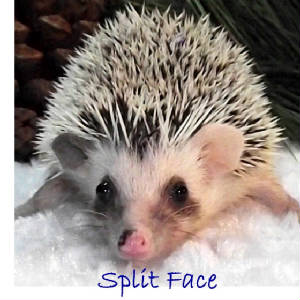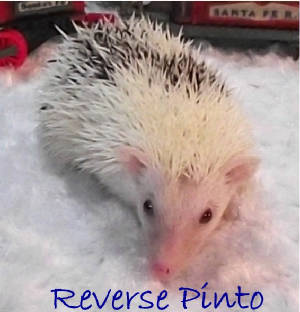Hedgehog, sugar glider, sto, short-tailed opossum, duprasi, squirrel, mouse, mice, rats, rabbit,
bunny, chinchilla, hamster, gerbil, rat, birds, guinea pig, degu, jird, dormouse, lemming, jerboa, prairie dog, chipmunk,
ferret, skunk, agouti, belgian hare, english lop

We are often asked for information on how to produce Split Face patterned babies. Rather than to reply to all of the individual
email that we receive we thought it would be easier just post some tips and guidelines that we use in our breeding program,
on our site. We hope it helps!
Breeding for Split Faces is a process…
Split faced coloured hedgehogs are hedgehogs that have a broken facial patterns. They are not very common and seem to be appealing
to fellow fanciers. They can have 50/50 Split faces, odd ears, white faces racoon eyes, mottled, blaze, etc.
To produce Split Face marked hedgehogs it is important to understand that both parents must carry the genes for snow flaking
and for spotting (AKA pinto). We have found that the more snow flaking and the more pinto patterning visible on both of the
parents the more likely it is that you’ll get babies with well defined markings. There is not a 100% guarantee that
you’ll get split face babies but the odds are favourable that at least some of the babies will be split faces.
Ideally, when starting out, try to purchase good quality, healthy stock that are the progeny (or the result) of a breeding
of a Silver Platinum / Snowflakes to High White Pintos. If possible reverse pintos are the best to start with. (Good quality
reverse pintos usually carry both of the genes and although it is easy to tell that they have a lot of pinto it can be very
difficult to tell the amount of snowflaking that is present but you can pretty much be reassured that most (if not all) reverse
pintos are carrying both genes)
We prefer to use one reverse pinto hedgehog (of either sex) and allow it to breed to one of the opposite sex that visually
displays more snow flaking and a medium amount of spotting (pinto). Typically, we choose not to breed two reverse pintos together
because the colours of the resulting baby’s will be somewhat less predictable.
Once you have a few unrelated reverse pintos and a few unrelated snowflake pintos to work with, you’ll be set to move
forward with your breeding plans of establishing your own Split faced breeding program.
When we breed for Split faced babies we prefer to use the darker coloured Algerians (Blacks, (Salt & Pepper), dark grey, chocolates,
browns etc.) because we prefer the babies have more colour contrast. We find that some of the lighter colours of split faced
hedgehogs such as cinnicot, cinnamon & champagne are still cute but they can look a bit washed out.

Breeding for Reverse Pintos…
Reverse Pintos are hedgehogs that have what appears to be a small spot /patch of a darker coloured quills set against a predominately
white quill body. There can be a single patch or just a few small patches or spots however if the amount of darker quills
covers more than 50% of the entire animal then it is likely not a reverse pinto. Single dark quills are not usually a true
indication that it is a reverse pinto because these quills are more often a result of the show flaking gene.
Reverse Pintos are quite uncommon. If you can not obtain a well defined reverse pinto to use in your breeding program, you
may be able to breed for that colour. To produce our reverse pintos, we pair 2 parents whereby one parent visually displays
a lot of snowflake (usually platinum / silver) and also a fair bit of spotting (pinto) then we breed it to an unrelated parent
that visually displays a lot of high white pinto and shows some obvious snow flaking. Once again there is no guarantee that
you’ll get reverse pinto babies but the odds are a little more favourable that at least some of the babies will be reverse
pintos
|

